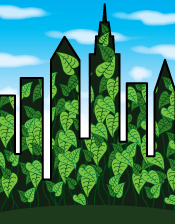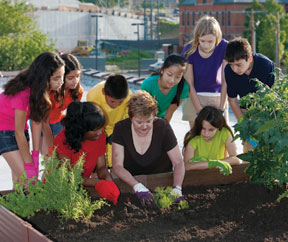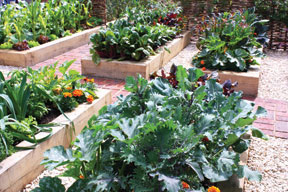
Growing Gardens in Urban Soils
- Home
- EPA Presentations
- Principles for Ecological Land Reuse
- Soil Science
- Soil Amendments
- Terrestrial Carbon Sequestration
- Plants and Revegetation
- Growing Gardens in Urban Soils
- Why is Healthy Soil Important for your Garden?
- What is a Soil Contaminant?
- How Do I Know if My Property is Contaminated?
- How Could I Come into Contact with Contaminants while Gardening?
- What Can I Do to Lower the Chances of Coming into Contact with Contaminants that May Be in Present in my Soil?
- Can I Use Phytoremediation to Remove Lead from the Soil at my Site?
- Where Can I Go to Find Technical Assistance for my Site?
- What Additional Resources are Available on this Topic?
- Ecosystem Services
- Creating Pollinator Habitats as Part of an Ecological Revitalization Project
- Act Locally
- Land Revitalization Assistance
- Case Study Profiles
- Publications, Resources, and Links
- Glossary of Ecological Land Reuse Terms

Communities are embracing urban agriculture and developing urban gardens on sites previously used for industrial and commercial purposes. In addition to the health benefits of gardening and fresh, local produce, a garden on formerly blighted land can become a new community asset with the potential to increase property values for adjacent properties, improve neighborhood aesthetics and grow social capital and community pride.
When deciding to garden on a potentially contaminated site, communities are encouraged to test their soil for qualities such as pH and nutrient availability and also to determine the amount and types of contamination, as well as the risks associated with those contaminants. The possibility of contamination should not deter you from planning an urban garden. There are steps you can take to assess, address and reduce the risks associated with your site's prior use to ensure a safe and healthy garden area.
This page provides information on the most common contaminants found in urban soils and links to resources to help communities start urban gardening projects on potentially contaminated properties. EPA also shares information about urban agriculture projects on potentially-contaminated properties at EPA's Brownfields Program Brownfields and Urban Agriculture: Interim Guidelines for Safe Gardening Practices. You can also download EPA's fact sheet addressing concerns about soil contamination and urban gardens.
- Common contaminants that can be found in urban soil.
- Ways to identify contaminants and reduce exposure.
- Improving soils & growing plants in mildly contaminated soil.
- Additional resources and technical assistance.
- This fact sheet is also available in Spanish.

 Tales from Urban Forests, a radio documentary series, explores the critical role trees play in the vitality of cities and their residents. The highlights local issues that are relevant to every community — from environmental and economic, to health and quality of life.
Tales from Urban Forests, a radio documentary series, explores the critical role trees play in the vitality of cities and their residents. The highlights local issues that are relevant to every community — from environmental and economic, to health and quality of life.Best Practices in the Garden
- Build raised beds.
- Locate gardens away from old painted buildings and roads with heavy traffic.
- Use a thick layer of organic material such as compost or mulch. Place landscape fabric between ground soil and new, clean soil.
- Watch over small children to stop them from eating soil through hand-to-mouth play.
- Wash hands immediately after gardening and before eating to avoid accidentally eating soil.
- Wear gloves as a barrier between your hands and the soil.
- Throw away the outer leaves of greens, especially from the bottom of plants, before washing. Soil particles are most likely to be located on the outer leaves of leafy plants.
- Wash produce using running water.
- Avoid bringing contaminated soil into the home by:
- Cleaning tools, gloves and shoes before bringing them indoors.
- Putting highly soiled clothes in a bag before bringing them indoors and washing them promptly in a separate load.
- Washing off excess dirt from crops, especially root crops and leafy vegetables, before bringing them indoors.
- Peel vegetables, especially root vegetables, which are in direct contact with soil.

Why Is Healthy Soil Important for Your Garden?
Healthy soil is essential for plants to grow in your garden. When a property has been used for industrial or commercial activities, the soil is often nutrient deficient, highly compacted and potentially contaminated. These soils can be improved and made healthy again so that your garden plants can grow and thrive. Healthy soil holds water and contains beneficial organisms, plant nutrients, and organic matter.
What is a Soil Contaminant?
A soil contaminant is an element or chemical present in the soil at a level that could possibly pose health risks. In a few areas of the country, element levels may be naturally high. In many cases, human activities have increased the soil levels of many elements and chemicals and also spread them out more widely. Lead, cadmium, arsenic, zinc, and polycyclic aromatic hydrocarbons (PAHs) are contaminants commonly found in any urban environment. In addition, other contaminants can also be found in areas near former commercial or industrial properties. This table displays sources of contamination that are commonly found on sites with a commercial or industrial history.
Table. Common Sources of Contamination1
| General Source | Examples of Previous Site Uses | Specific Contaminants |
| Paint (before 1978) | Old residential buildings; mining; leather tanning; landfill operations; aircraft component manufacturing | Lead |
| High traffic areas | Next to heavily trafficked roadways or highways; near roadways built before leaded fuel was phased out | Lead, Zinc, PAHs |
| Treated lumber | Lumber treatment facilities | Arsenic, chromium, copper |
| Burning wastes | Landfill operations | PAHs, dioxins |
| Contaminated manure | Copper and zinc salts added to animal feed | Copper, zinc |
| Coal ash | Coal-fired power plants; landfills | Molybdenum, sulfur |
| Sewage sludge | Sewage treatment plants; agriculture | Cadmium, copper, zinc, lead, persistent bioaccumulative toxins (PBTs) |
| Petroleum spills | Gas stations; residential/commercial/industrial uses (anywhere an aboveground or underground storage tank is or has been located) | PAHs, benzene, toluene, xylene, ethyl benzene |
| Pesticides | Widespread pesticide use, such as in orchards; pesticide formulation, packaging and shipping | Lead, arsenic, mercury, chlordane and other chlorinated pesticides |
| Commercial/Industrial site use | PAHs, petroleum products, solvents, lead, other heavy metals (such as arsenic, cadmium, chromium, lead, mercury and zinc) | |
| Dry cleaners | Stoddard solvent and tetrachloroethene | |
| Metal finishing operations | Metals and cyanides | |
| EPA's Toxic Release Inventory (TRI) database can provide information to communities about sites where contaminants were released into the environment. | ||
http://www.ruaf.org/sites/default/files/guide%20on%20soil%20contamination.pdf
How Do I Know if My Property is Contaminated?
You can conduct a formal environmental assessment (study) of the land you are interested in using for urban gardening. There are two types of assessments: Phase I and Phase II Environmental Site Assessments. A Phase I assessment includes a review by a trained environmental professional of historical site uses, interviews with neighbors and, if possible, site owners, and a visual site inspection to determine the potential for and type of contamination at a site. If a Phase I assessment determines that there is potential for contamination at the site, a Phase II assessment is conducted to sample for contaminants and locate any impacted areas.
Federal funding is available to government entities to conduct brownfields (property where reuse may be complicated due to on-site contamination) assessments. Working with local officials to apply for an EPA brownfields grant can provide money for your community to assess or clean up the property you are interested in as well as address other properties.
How Could I Come into Contact with Contaminants while Gardening?
An exposure pathway is the way that a contaminant comes into contact with people. If a site assessment concludes that contaminants are present, the next step is to think about potential contaminant impacts as you work the soil to garden or eat the food you grow. There are two human exposure pathways to soil contaminants: the soil-to-human pathway and the soil-to-plant-to-human pathway.
What Can I Do to Lower the Chances of Coming into Contact with Contaminants that May Be in Present in my Soil?
These techniques are commonly used to eliminate exposure to soil contaminants:

- Build raised beds.
- Use soil amendments to stabilize contaminants in soil. Adding a thick layer of organic matter to your soil provides a physical barrier to contamination.
- Remove all contaminated soil and replace it with clean soil.
- Use phytotechnologies, Keep in mind that phytoremediation can take many years, is not effective for every contaminant, and generally requires special handling for the disposal of plants used.
Can I Use Phytoremediation to Remove Lead from the Soil at my Site?
No. Phytoremediation of lead in soils is ineffective since lead is generally not available for plant uptake.
Where Can I Go to Find Technical Assistance for my Site?
U.S. Department of Agriculture extension services
EPA's Technical Assistance to Brownfields (TAB) program
TAB Providers:
State and Tribal Brownfields Programs:
- State Brownfields Programs, EPA Office of Brownfields and Land Revitalization
- Tribal Brownfields Programs, EPA Office of Brownfields and Land Revitalization
What Additional Resources are Available on this Topic?
EPA Resources
- EPA's Superfund Redevelopment Initiative. Superfund Redevelopment at EPA helps communities return some of the nation's worst hazardous waste sites to safe and productive uses. In addition to cleaning up these Superfund sites and making them protective of human health and the environment, the Agency is working with communities and other partners in considering future use opportunities and integrating appropriate reuse options into the cleanup process.
- Brownfields and Urban Agriculture: Interim Guidelines for Safe Gardening Practices. This document presents a process and set of recommendations for developing agricultural reuse projects on sites with an environmental history. Potential gardeners, state environmental agencies and regulators can use this process to determine how to address the risks inherent to redeveloping brownfields for agricultural reuses while being protective of human health.
- Urban Farm Business Plan Handbook. This Handbook provides a framework for any organization or community interested in developing an urban farm on cleaned brownfields or vacant sites to help address neighborhood blight, food access, or community development challenges. The handbook provides guidance on how to assemble marketing, operating, and financial strategies to communicate your urban farm project to potential partners and funders.
State and Local Resources
- ASTSWMO Community Gardening Toolbox. The Toolbox is designed to assist States by providing a reference guide for State environmental staff on community gardening at brownfield sites. States are encouraged to personalize the toolbox by adding their own State-specific and other regulatory information to increase the documents applicability and usefulness.
- Gardenroots. Gardenroots is a partnership between the community of Dewey-Humboldt, Arizona and scientists at the University of Arizona, where Citizen Scientists from the area will collect soil, water and vegetable samples from their garden for analysis to determine the levels of metals in their home grown vegetables. Over time these efforts will enable scientists and community members to improve their scientific understanding of soil and vegetable quality in the area.
- Native Orchids Need their Pollinators. This resource, created by the Pollinator Partnership, describes in detail how certain species of native orchids depend on successful pollination by a specific pollinator. It is a useful resource for ornamental urban gardens that plan on hosting native orchid species.
Soil Quality
Contaminants
- The EPA Sector Notebook Series is a set of profiles containing information on specific industries.
- EPA's Toxics Release Inventory Program provides useful information about the history of individual sites.
- The University of North Carolina Superfund Research Program's Fact Sheet on Arsenic and Lead Bioavailability in Soils at Superfund Sites has information on these two contaminants, their effects on human health, exposure and risk assessment, and what individuals can do to reduce exposure.
Information about the health effects of particular contaminants is available at:
- The Agency for Toxic Substances & Disease Registry (ATSDR)
- EPA's Integrated Risk Information System (IRIS)
- The Risk Assessment Information System
Techniques for Addressing Soil Contamination
- The Use of Soil Amendments for Remediation, Revitalization, and Reuse
- Urban Agriculture and Soil Contamination: An Introduction to Urban Gardening
- EPA fact sheet on brownfields redevelopment and local agriculture: How Does Your Garden Grow?
- EPAs fact sheet on phytotechnologies: Phytotechnologies for Site Cleanup
Funding Opportunities
- Local Foods, Local Places Grants
- EPA Brownfields Assessment Grants: Interested in Applying for Funding?
- Grants & Funding Opportunities provided by the EPA Office of Brownfields and Land Revitalization





